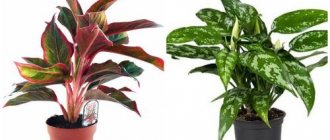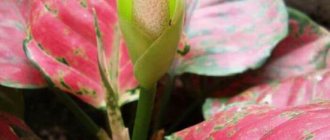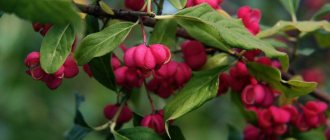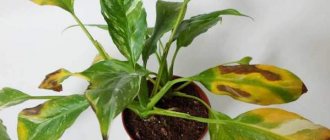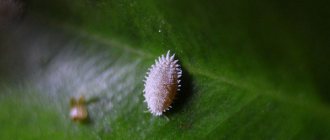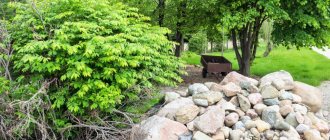Description of Fortune's euonymus
Fortune's euonymus in Latin, Euonymus fortunei (alluring with beauty), became the basis for breeding work to develop new plant varieties. They are widely used in the design of sites, recreation areas, city squares and parks. The low-growing shrub attracted the attention of botanists due to the exotic color of its leaves, the decorative nature of the bush and its ability to preserve the crown throughout the winter.
A distinctive feature of Fortune is the unusual color of the foliage, which depends on the plant variety and time of year. There are evergreen species without changing color in autumn. Others change color dramatically. The common shade of the crown is emerald with yellow splashes on the leaves or dark green with silver fragments. The leaves, elongated up to 5 cm in length, are closely spaced along the stem; visually the shrub has a lush shape, without gaps.
Is Fortune's euonymus a poisonous plant or not?
By autumn, the plant produces fruits with a high concentration of toxic substances. Poisonous berries are not eaten. Selected varieties of shrubs rarely bear fruit. Fortune blooms profusely in the wild with inconspicuous greenish flowers. The formation of inflorescences on a creeping plant is found in regions with warm climates. Therefore, euonymus can only be considered half poisonous. The sap of the plant is non-toxic, it practically does not bloom, there are no inflorescences or fruits. In general, Fortune's euonymus (Euonymus fortunei) is safe.
Height of Fortune's euonymus
In southern latitudes, Fortune's euonymus of a selected species grows up to 60 cm, in the natural environment - 30 cm. Side shoots can reach up to 3 m, regardless of the type of shrub. Nodular formations form along the stem, they become the basis for root growth. If you place a support near the Fortune euonymus and direct the growth of side shoots, the plant will rush upward. This technique creates all kinds of shapes on the site.
Winter hardiness of euonymus Fortune
On the territory of the Russian Federation, the range of the species is the Far East, the European part of Russia, Southern latitudes. Thanks to the ability:
- withstand temperatures down to -25 °C;
- ease of care;
- tolerate drought without constant watering.
Fortune's euonymus is capable of growing throughout almost all of Russia, except for regions with risky farming. The plant is in demand among professional designers; the shrub is not popular among gardeners; it is treated as an exotic plant for an amateur.
Care
Fortune's euonymus withstands low temperatures well, can take root in partial shade and does not require constant feeding. Despite this, shrub care should still be carried out regularly. Only in this case will it delight you with its unusual chic appearance and become a real decoration of the site.
Watering
Fortune's euonymus is a drought-resistant plant, so it can withstand the heat for some time without watering. However, this will worsen its growing season. Ideally, you need to ensure that the tree trunk never gets too dry. The average watering frequency in moderate weather is twice a week. When the thermometer rises to 30°C, it is better to water daily, but in the rain you should avoid additional irrigation.
Top dressing
The unpretentiousness of Fortune's euonymus also lies in the fact that it does not require any specific feeding schedule or specific fertilizers. However, to maintain its decorative properties, you should not leave it without them. The application scheme is minimal and typical for many plants:
- April - organic;
- end of summer - phosphorus, potassium sulfate, superphosphate;
- autumn - slaked lime.
The plant requires additional feeding during periods of illness or pest invasion.
Trimming
In the spring, sanitary pruning is required: damaged, frozen, dry shoots and leaves are removed. After this, you can make a shaping haircut. There are 2 ways to beautifully arrange this shrub on your site.
Formation of Fortune's ground cover euonymus
In order for the plant to form a dense decorative carpet, immediately after planting the shoots bend down to the ground as much as possible. This sets the desired direction in which they should grow. Next, they are all cut to the same length to give the bush a decorative appearance. Throughout the season, shoots that grow faster than others and stand out from the general mass should be trimmed. Those branches that begin to stretch vertically (stretch towards the sun) should be bent to the ground.
Formation of Fortune's euonymus on a trunk
This form is suitable only for high varieties. After planting, the main trunk and several skeletal branches are immediately identified on the seedling. The rest are cut off. If the shoots continually tend to fall to the ground (the nature of the ground cover affects them), in the first year you can raise them with the help of supports.
Formative pruning is carried out regularly. Branches falling out of the designated silhouette should be trimmed immediately. In the fall, old ground covers can be cut off almost at the root - in the spring the plant will produce new, fresh, young shoots.
Mulching
In spring and autumn, the old layer of mulch is removed and a new layer is laid. Most suitable material:
- sawdust;
- humus;
- needles (the best are pine);
- peat;
- old foliage;
- a mixture of all of the above.
Autumn mulching protects shrubs from freezing in winter, spring mulching retains moisture in the soil.
Preparing for winter
Fortune's euonymus has a winter hardiness zone of 5; it can withstand frosts down to -25°C. But individual varieties may be more or less frost-resistant. If the roots are frozen, but not too much, they quickly repair themselves. To avoid the death of the plant, it is recommended to cover it. Material suitable for this purpose:
- spruce branches;
- straw;
- non-woven fabric;
- dry leaves.
Before covering for the winter, the soil around the plant can be sprinkled with the same straw, sawdust or pine needles to further protect the shrub.
Note. These tips are mostly for those who grow Fortune's euonymus in northern areas with fairly cold winters. In those regions where the temperature does not drop below -10°C, there is no need to cover the beautiful shrub; it will decorate the area with its unfading appearance throughout the cold season.
Treatment and prevention of diseases
The most common diseases and pests of the described plant are powdery mildew, spotting, rust, gray mold, as well as aphids, spider mites and scale insects. The best way to treat and prevent fungal infections is treatment with fungicides:
- Bordeaux mixture;
- Home;
- Topaz;
- Soon;
- Fitosporin, etc.
Insecticidal preparations help control insects:
- Aktellik;
- Fitoverm;
- Spark;
- Karbofos et al.
This species is considered resistant to phytopathologies, so with proper care such problems do not arise.
Fortune's euonymus in landscape design
Euonymus Fortune ornamental trees and shrubs are used by designers in the design of the territory. The ground cover plant is good for:
- For landscaping city parks, alleys, squares.
- Like an imitation of lawns.
- Creating a hedge.
- Curb markings.
On the site, if positioned correctly, you can create a fantastic picture of bizarre shapes. Euonymus spreads densely along the ground, preventing weeds from growing. This feature is used in the design of the base of the flower bed. When solving the problem of creating a border between zones, Fortune with colorful leaves will be a godsend for designers and gardeners.
An evergreen shrub in early spring will give the garden a neat look, as a background accent in a composition with plants of different flowering periods. Visually emphasizes the uniqueness of the palette. Shrubs are used in almost all style directions. It is included in the composition of flowers and low-growing trees. Planted in a group of different varieties or as a single plant. Areas of application of euonymus:
- alpine slides;
- framing wooden benches along the alley;
- around the gazebo;
- artificial reservoirs on a personal plot;
- outline the paths and the fountain setting.
Medium-sized euonymus shrubs are placed to form bosquets (woods), using the method of artistic pruning, creating silhouettes of animals, castles, compositions for any flight of fancy.
Shrubs planted in parallel create a sense of solemnity and order. Fortune during the period of lush growing season of flower crops is an auxiliary background, and the main one in late autumn and winter. Fortune's euonymus is especially popular in the Moscow region in summer cottages and areas of country houses.
Cultivation
Possessing highly decorative properties, Fortune's euonymus is used in different ways in landscape design. Here are just some of the options:
- rocky gardens;
- imitation lawns;
- alpine slides;
- borders and parterres;
- coniferous compositions;
- heather, Japanese gardens;
- decor for garden buildings (gazebos, pergolas) and furniture (benches);
- decoration of artificial reservoirs;
- mixborders;
- solo plantings;
- vertical landscaping of the site;
- If grown as a shrub rather than a ground cover, Fortune's euonymus will look quite good in a hedge.
Another important feature of Fortune's euonymus is that it tolerates dirty, polluted air and dust well. Therefore, it is often used in urban landscape design of local areas, in park compositions, and squares.
Varieties of euonymus Fortune
Fortune's euonymus has more than 150 species, some of them are used for landscaping as a ground cover option, others in the form of vertical landscaping methods. The most popular varieties in design, which can often be found in recreation areas, city flower beds, and private areas.
Euonymus Fortune Emerald Gold
Fortune's euonymus "Emerald gold" (golden emerald) is a low-growing shrub up to 40 cm, used in vertical gardening, capable of climbing up to 2 m on a support. The growing season of the variety is long, the euonymus reaches its end point of growth in the 5th year after planting. The Emerald gold variety is a frost-resistant plant that easily tolerates low temperatures (-23 °C) without additional covering of the root system.
External description:
- leaves of medium size, in the shape of an elongated oval with a pointed end;
- the structure is rigid, the surface is glossy, the sheet is slightly carved along the edge;
- two-color coloring, the dominant tone is bright yellow with light green fragments in the middle;
- by autumn the color changes to dark red with a brown tint, the surface color is uniform;
- branches are rigid, of medium thickness, intensely leafy;
- in southern latitudes it blooms with inconspicuous green flowers;
- fruits are bright red, round in shape.
Attention! Euonymus Emerald Gold is a light-loving plant; growth stops in a shaded area.
Euonymus Fortune Emerald Haiti
Fortune's euonymus "Emerald gaiety" is one of the popular varieties. Distributed in regions with temperate climates. The most frost-resistant species of euonymus. Unlike other species, it does not stop growing in shaded areas on the north side. The evergreen shrub does not shed its leaves for the winter, it only changes their palette.
A low-growing plant, Fortune no higher than 30 cm, forms densely growing shoots 1.5 m with intense foliage. The crown is lush, rounded, without gaps.
Designers are attracted by the decorative nature of Fortune’s crown:
- sheet size 3 cm;
- elliptical shape;
- the surface is painted in a bright green color along the edge with a white border, this combination gives the euonymus a neat, elegant look;
- the color changes in winter, the leaves acquire a uniform pink color;
- The stems are thin, flexible and take root well when in contact with the ground.
Looks harmonious in combination with flower crops. Euonymus is used to decorate borders, edges of ridges, and voids in a flower bed. In design it is used as a ground cover plant.
Euonymus Fortune Harlequin
Euonymus fortunei Harlequin is a dwarf variety, one of the smallest of the species. It does not grow more than 25 cm in height. In the design, the territory plays the role of the foreground. Full owner of city flower beds, parks, and recreation areas. Ideal for masking the unaesthetic appearance of urban communications.
Fortune is formed by a large number of thin herbaceous shoots, abundantly leafy. The decorative appearance of the plant is given by bright green, oval leaves, along the surface with fragments of specks of white, beige, and yellow tones. By autumn the leaves become light pink.
In the south, the plant blooms with waxy inflorescences in the form of a green or beige ball. The fruits are bright red. The plant does not tolerate excess ultraviolet radiation; in an area exposed to the sun, leaf burns are possible. Not suitable for growing in temperate climates. Euonymus "Harlequin" is not frost-resistant.
Euonymus Fortune Silver Queen
The euonymus variety Silver Queen (Silver Queen) is used in the design of the territory as a creeping shrub and in the form of a liana-like plant. One of the few representatives of the species whose shoots grow up to 45 cm during the seasonal growing season. The bush does not stop growing in the shade and in the sun. Does not require special care. Unpretentious to temperature changes, frost-resistant, tolerates drought well. Distribution area: European part of Russia. Silver Queen is a selection variety with a height of 70 cm.
External description of the variety Euonymus Fortune “Silver Queen”:
- the plant does not shed leaves;
- the crown is dense, spherical;
- easily climbs onto trellises;
- stems are light pink, strong, elastic;
- the leaves are oval, slightly elongated, painted in a rich green color with a pronounced white border along the edge;
- the surface of the leaves is glossy, waxy, hard.
In autumn the bush turns dark red. This variety practically does not bloom and does not bear fruit. It is used in design in the form of a hedge, to form bosquets and ponds.
Euonymus Fortune Sunspot
Euonymus Sunspot “Sunny Bunny” is a low-growing creeping plant 25 cm high. Shoots are about 1.2 m. Small leaves on the shoots are densely located, forming a lush spherical crown. The variety grows quickly (30 cm per year), is frost-resistant, and does not require lighting. A shaded place does not affect the decorative appearance of the shrub.
The leaves are 2.5 cm long with a dark green color with a bright yellow spot at the base, similar to a sun flare. Grown in the Far East, in Siberia for the design of the first plan of flower beds. Combines harmoniously with tall shrubs and flowering crops. Used for framing fountains, borders, alpine slides.
Euonymus Fortune Coloratus
The low-growing variety Coloratus is recognized as the best for growing in the shade of trees. The plant feels equally comfortable in the sun and without it. It forms a multiple number of shoots, which at a height of half a meter create a continuous covering of the crown. Easily climb up a tree trunk or a specially installed support. This euonymus variety can reach 5 m in height. Creates the appearance of a green continuous cascade.
The leaves are a uniform light green color, up to 5 cm in diameter, with an opposite arrangement on the stem. In landscape design, euonymus is used for a green accent in a rock garden among stones; it is a suitable variety for hedges, ridges, and rock gardens.
How to care?
Caring for an indoor miniature tree is a simple procedure. Even an inexperienced gardener can grow an euonymus bush.
Watering
This representative of the flora requires moderate irrigation. Too much watering is detrimental to it. In very hot weather, it is worth irrigating the crop more often than on cloudy days. There is no need to allow the soil to dry out. You can check the soil moisture by dipping a wooden stick into it. As a rule, 1 irrigation every 3-4 days will be enough for a miniature tree.
Spraying indoor plants has a beneficial effect on their growth and development. A weekly shower with warm water is of particular benefit to apartment residents. This procedure can not only wash away dust from the foliage, but also acts as a prophylactic against many parasites.
Indoor euonymus should be sprayed and watered only with warm water of minimal hardness. Otherwise, whitish spots will appear on its foliage. Drought for this representative of the flora is not as terrible as waterlogged soil.
If you regularly and abundantly water a tree, you can destroy it.
Top dressing
The crop does not need a large amount of fertilizers. Provided that the soil is selected correctly, monthly watering of the euonymus with dissolved mineral complex fertilizer will be sufficient. This type of feeding is required for a miniature tree from early spring to mid-autumn. The application of organic fertilizers is considered acceptable. Alternatively, you can use infused fresh mullein, bird droppings, green nettles, and dandelion leaves.
Trimming
Since indoor euonymus has the appearance of a miniature tree or bush, it requires regular sanitary pruning. The plant should be cut off all weak, dried out, deformed shoots. This procedure can stimulate the formation of young buds and branches. In order to increase the splendor and bushiness, it is worth pinching each shoot by 2-3 buds.
Indoor euonymus can also be trimmed for decorative purposes. If desired, the crown can be made in the shape of a ball, a pyramid, or even a cone. Some gardeners show imagination and create unusual living sculptures from plants. Since the euonymus has poisonous sap, its shoots must be trimmed using rubber gloves only.
To carry out the procedure, the instrument must be sharp and disinfected.
Wintering
From mid-autumn until the last day of winter, this representative of the plant world continues to have a dormant period. At this time, the plant must be placed in a cool place, otherwise it will remain without leaves. Alternatively, the flower can be displayed on a glassed-in loggia.
During the resting phase, watering the tree should be more moderate; once every 8 days will be enough. Feeding the bush should be stopped during this period. Bright lighting is still vital for this representative of the flora, so for the winter the flower pot should be moved to a south window.
Planting and caring for Fortune's euonymus
Euonymus is planted in early spring or autumn. For temperate climates, late planting is not recommended; the plant does not have enough time to take root. Most varieties safely tolerate low temperatures; a young bush planted in the fall with a weak root system may die. It is better to plant the plant in a pot and place it indoors, and move it to a permanent place in the spring.
Rules for planting Fortune's euonymus
The plant has a superficial root system that does not require significant deepening of the planting hole. Its size corresponds to the size of the root of a young plant; it must be completely located in the hole, at least 10 cm to the edge. Planting algorithm.
- Drainage (pebbles, small stones) is placed at the bottom of a pre-prepared hole.
- Turf soil is mixed with compost and river sand.
- Place the seedling vertically and cover it with soil, ensuring that the root collar remains above the surface.
- The root circle is mulched with humus, sawdust, and peat.
Advice! It is recommended to create a shallow ditch around the euonymus for irrigation.
Planting work is carried out in April or late September.
Watering and fertilizing
Fortune's euonymus is a drought-resistant plant that can survive without watering for a certain period of time. Moisture deficiency will not cause the death of the plant, but the growing season will slow down. If there is heavy rain three times a month in the summer, the shrub does not require additional irrigation.
Euonymus is watered immediately after placement on the site. During the dry season, the plant is watered as the soil dries out. If sawdust was used as mulch, the moisture in the root circle will remain longer.
To ensure that the plant does not lose its decorative appearance and the color of the crown is bright, it is recommended to apply fertilizer. The first feeding is done in April with organic matter, and at the end of August with phosphorus-potassium preparations.
How and when to prune Fortune's euonymus
The crown of the bush is formed in early spring and late autumn, when sap flow stops. At the beginning of the growing season, dry fragments are cut off and the euonymus is given the desired shape. The shrub does not grow quickly, but at the end of the season the shape is disrupted by protruding shoots; it is recommended to cut them off. Euonymus tolerates severe pruning at the root. If the root system is not damaged, the plant will produce friendly shoots in the spring.
Transplantation of Fortune's euonymus
Place the plant on the site according to the varietal characteristics. Planting and subsequent care of Fortune's euonymus "Emerald Gold" is carried out only in a well-lit area; the plant is not tolerant of ultraviolet deficiency. Soils suitable for all types of shrubs are neutral, slightly acidic, with sufficient nitrogen content, fertile. Most of the popular varieties are planted in the shade, for example, planting and caring for the Fortune Emerald Haiti euonymus is recommended in the shade of trees or the wall of a building.
Planting material is purchased from a retail chain or obtained from the parent plant. If it is necessary to move an adult plant to another place, choose a time in the spring, when the soil has warmed up enough and sap flow has not begun.
Preparing for winter
Almost all Fortune varieties tolerate frost well. No special measures are required to cover the plant. If it freezes, the root quickly recovers. In late autumn, it is enough to cover the euonymus with fallen leaves, and in winter with snow.
Care
Euonymus is considered an unpretentious plant.
Watering
This is a drought-resistant plant that can survive without water for several days. However, in such spartan conditions, its decorative properties suffer - the leaves stop sparkling in the sun and become dull. Basic rules of watering:
- do not allow the tree trunk circle to dry out completely;
- in the absence of rain, water twice a week;
- Make sure that water does not stagnate in the tree trunk circle.
To ensure that the euonymus does not suffer from a lack or excess of moisture, it must be provided with high-quality drainage even during planting.
Top dressing
Timely application of the necessary fertilizers will provide high decorative properties and strengthen the plant’s immunity. Scheme:
- in the spring, during the formation of buds, treatment is carried out with mineral compounds or organic matter (mullein, bird droppings);
- in summer, during flowering, complex fertilizers are applied (potassium + phosphorus + nitrogen);
- in the fall, in October, the plant will need mineral fertilizers and organic matter: wood ash, compost, slaked lime, superphosphates, potassium.
Applying fertilizers outside of the schedule is possible if the plant is sick or has been attacked by pests.
Trimming
Euonymus tolerates pruning well. It seems as if he was created for this procedure. It is shearing that allows you to give a tree or shrub the shape that will decorate the area. What you need to do for this:
- Study the information about what form is usually given to the species and variety that will grow on the site.
- For example, on a trunk, pruning is done for trees (European or Greatwing). One main trunk is left and the skeletal branches are selected. The rest are deleted. The crown is most often spherical.
- Shrubs have 2-3 main trunks left, the remaining branches are cut off. The crown is again chosen to be traditional - spherical.
- The easiest option is to form a ground cover euonymus. Throughout the season, shoots growing in the wrong direction are cut off, while they are given the right direction.
- Do not forget to carry out sanitary pruning every spring, removing dry, diseased branches damaged after wintering.
Using this procedure, you can control the height of the plant.
Mulching
As practice shows, euonymus grows well even without mulching. However, those who are sensitive to their shrubs sprinkle the tree trunk circle with various materials. In spring and summer, mulch performs the function of moisture retention. This option is acceptable when the owner of the site comes to the dacha once every 1-2 weeks. To prevent the soil from drying out, it is enough to water the plant well before leaving. In winter, this layer will become a kind of insulation and will prevent the soil from freezing. What is commonly used for mulching:
- pine needles (pine is the best), conifer bark;
- straw;
- sawdust, wood chips;
- humus;
- dry fallen leaves;
- moss;
- peat.
The layer of mulch must be changed regularly to prevent diaper rash and mold from forming. Otherwise, an environment favorable for fungal infections will form, and the plant may get sick. The old layer must be renewed twice a year - in the spring and before wintering. Additionally, you can do this a couple of times during the summer - such a procedure will definitely not be superfluous.
Preparing for winter
Most species and varieties of euonymus are highly winter hardy. For example, the European one without insulation can survive frost of -30°C, the winged one - -34°C. However, some varieties still need preparation. This is especially true for low-growing species. What measures should be taken:
- make sanitary pruning;
- apply fertilizers;
- water generously;
- cover the tree trunk circle with spruce wood, agrofibre or straw;
- install a wooden frame over the plant;
- throw a dense but breathable covering material over it (this can be polymer, burlap, geotextile, jute mesh, composite fabric).
As for care directly in winter, a protective screen is built in February to reflect the bright rays of the sun so that the plant does not get burned.
Treatment and prevention of diseases
Euonymus is one of the most beneficial plants for a gardener. It is not only unpretentious, but also highly resistant to diseases. In particular, to fungal infections. However, during an epidemic, infection is quite possible. In such cases, treatment with fungicides, Bordeaux mixture, and copper oxychloride is required. What pests usually plague this plant:
- powdery mildew;
- rust;
- spotting;
- gray rot.
Pests that bother you much more often:
- spider mite;
- mealybug;
- caterpillars;
- scale insects;
- aphid;
- hawthorn;
- apple moth.
To rid the plant of insects, it is treated with insecticides. Preventive measures include:
- agrotechnical measures: planting as far as possible from fruit and berry crops, hanging traps;
- in spring and autumn, complete treatment with fungicides and insecticides.
Reproduction of Fortune's euonymus
Creeping species are bred in several ways:
- dividing the bush;
- seeds;
- cuttings:
- layering.
Gardeners choose the best method for themselves.
Propagation of Fortune's euonymus by cuttings
Planting material is harvested in the summer from green, non-woody shoots. Cut cuttings 10 cm in size and plant them in a container with fertile soil, pre-treated with a root growth stimulator. A cap is made of polyethylene on top and placed in a shaded place. After 30 days, Fortune will give roots. The cuttings are transplanted to the wintering site, or to the site in the spring.
Seeds
Before planting seeds, they are treated with a 5% solution of potassium permanganate. Sown in turf soil mixed with river sand. After three months, shoots will appear and they will be planted in separate containers. They remain in this state for 30 days, then they are placed in a certain place on the site. Sowing of seeds is carried out at the end of January. You can plant the seeds directly into the ground in the spring; by autumn they will sprout; for the winter, the young shoots are covered in a mini-greenhouse.
Dividing the bush
This is the most effective way to breed euonymus. An adult plant is dug up. Divide the root system into the required number of parts. Each lobe has a growing point, a root and several young shoots. They are planted around the area.
By layering
Creeping euonymus in the wild reproduces by layering. Upon contact with the soil, adventitious roots on young shoots take root. They are separated from the main bush and planted on the site. You can propagate Fortune's euonymus yourself. To do this, dig in an annual shoot, it produces roots, divide it, and plant it in a permanent place.
How to plant in open ground?
Planting euonymus in the garden in open ground is carried out only in a partially shady place
It is important to remember that excess sunlight will deteriorate the decorative properties of the deciduous plates of the shrub and cause them to fall asleep. The crop has no special requirements regarding soil. The best solution would be a combination of part of leaf soil, the same amount of peat, a couple of parts of turf or garden soil, as well as river sand
If the soil in the selected area is acidic, then lime should be added to it immediately
The best solution would be a combination of part of the leaf soil, the same amount of peat, a couple of parts of turf or garden soil, as well as river sand. If the soil in the selected area is acidic, then lime should be added to it immediately.
Planting is carried out from May to September on a sunny or rainy day. The hole is formed in such a way that its volume is a couple of times greater than the size of the root system. A drainage layer is formed at the bottom, created from pieces of brick, crushed stone and expanded clay. Next, compost or humus is laid out, and then soil. The seedling is placed vertically in the hole, its roots are covered with soil mixture. Finally, the surface is compacted and properly irrigated.
Diseases and pests
Selected varieties of Fortune's euonymus inherited stable immunity from wild plants against all types of garden pests. With high humidity and low air temperatures, Fortune is affected by a fungal infection, powdery mildew. The disease manifests itself as a gray coating on the leaves. If you do not treat the plant with fungicides (Bordeaux mixture), the foxes dry out and fall off. The bush takes on an unaesthetic appearance. To prevent the euonymus from dying, reduce watering, apply nitrogen fertilizer, and cut off damaged fragments.
